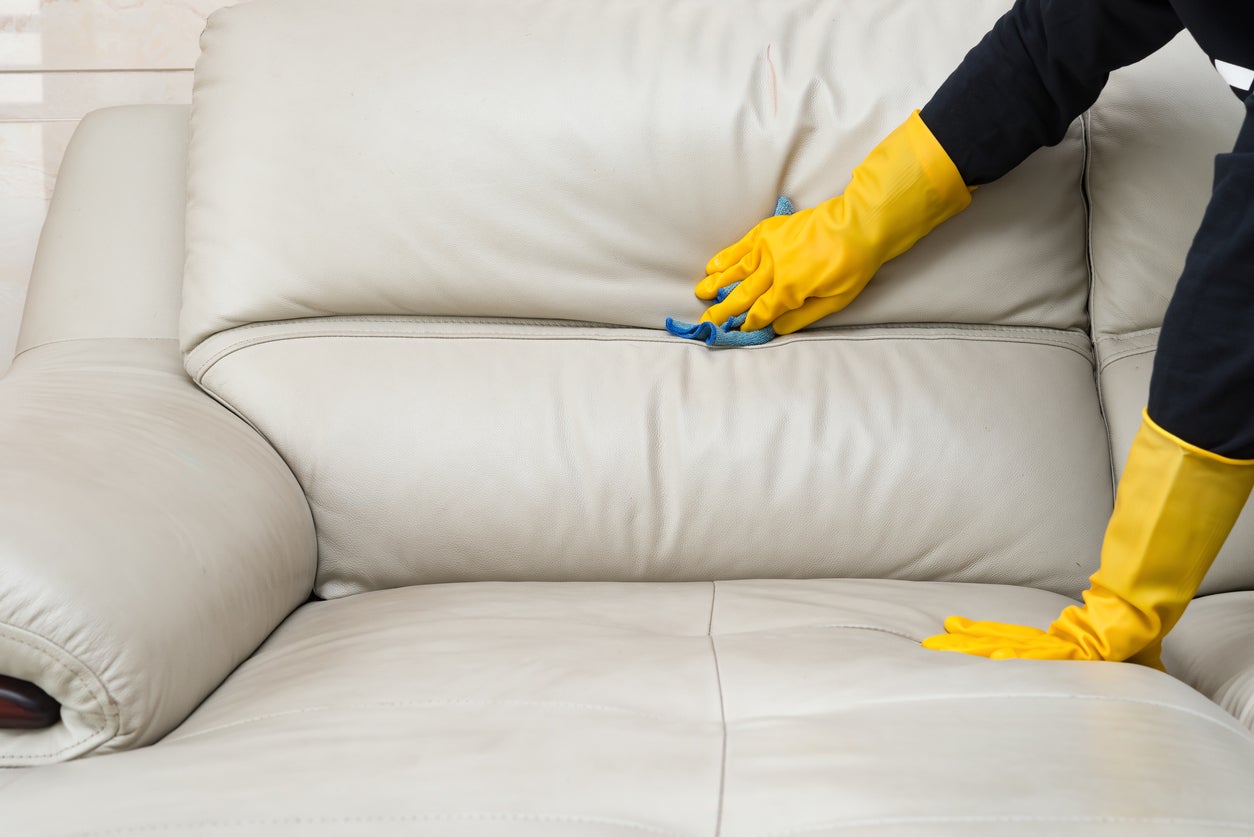Leather is a durable and low-maintenance surface for furniture. If you take the right steps, it’s easy to keep your leather chair or sofa clean. You must first identify the type of leather that you own. How to identify, clean, and maintain leather upholstery.
Leather Upholstery Types.
Check the label and the written material that came with your leather furniture, or search the website of the retailer or manufacturer to find out the type and recommended care. Here are some clues if you do not have the care instructions or you’re unsure of what type of leather you own.
Unprotected leather.
Full aniline leather, also known as pure aniline leather, has a luxurious, soft feel. The leather is dyed with aniline, but no pigments are added to the surface. The leather has a minimal or non-existent protective coating other than a treatment that makes it dirt resistant. Leather can have natural surface markings and grains.
Aniline leather tends to be more expensive and is also more susceptible to staining. Aniline leather also includes pull-up leather that is injected and waxed, as well as nubuck leather which has been distressed and buffed for a velvety, soft feel.
Protected or finished leather.
The majority of leather furniture is made from protected or completed leather. These leathers can be labeled as semi-aniline leather, aniline leather with pigment, or pigmented. Protected leather has a uniform appearance, is stain resistant, and is more durable than pure aniline.
Semi-aniline leather has been aniline dyed and then topped with a pigment color. The leather is soft and similar to pure aniline, but the coating of protective pigment makes it more durable. Some leathers that are protected have thicker layers. These leathers are stiffer and can withstand more wear.
How To Care For Leather Upholstery.
Avoid DIY solutions when it comes to cleaning leather upholstery.
Keep it simple. Keep homemade solutions containing vinegar and mayonnaise for salads and sandwiches, and leave them on the leather cleaning menu. Leather Furniture, she has seen customers damage their furniture using everything from Pine-Sol to hair-care products. Remember that leather furniture warranties can be void if you use the wrong cleaners or conditioners. The most important thing to do is avoid using anything not approved by tanneries.
Cleaning material:
– Vacuum with a brush attachment
– Distilled water
– A mild, non-detergent liquid detergent, such as Neutrogena, Dove, or leather cleaners designed for upholstery
– White microfiber soft cloths
– Drop cloth or tarp
– Commercial leather conditioner
Cleaning leather that is not protected.
Many furniture manufacturers recommend dusting aniline leather without protection with a dry, clean cloth and vacuuming the leather regularly using a brush attachment. Some furniture makers recommend gently wiping down the surface using a dampened cloth or a leather cleaner. Take care to avoid scratching or staining the natural appearance. Before using any leather products, consult the cleaning instructions of the manufacturer or a professional leather lounge cleaning in sydney. Test them first on a hidden area.
Cleaning leather that has been protected.
Semi-aniline, and in particular pigmented leather, can with stand heavier cleaning and use than aniline leather. According to the Institute of Inspection, Cleaning, and Restoration Certification, products that contain ammonia and alkalies can permanently damage leather. Avoid saddle soaps, detergents, and oils. Also, avoid furniture polishes.
Cleaning methods
Follow these steps to clean leathers that are protected. Try them out first in a place that is not visible. Put down a drop cloth to catch any drips.
- Use the brush attachment to vacuum the furniture.
- To create a cleaning agent, add a few drops of distilled water from a mild nondetergent detergent soap. Then, dampen a microfiber towel with the solution.
- Check a small area with the cloth for discoloration.
- Wipe the furniture from top to bottom.
- Wipe the furniture with a damp cloth that has been dipped in plain distilled water.
- Towel dry with a clean one.
Spills And Spots
Leather is sensitive to liquid spills. They should be cleaned up as quickly as possible.
Unprotected Leather.
To absorb spills or stains from pure aniline leather, use a dry, clean white cloth. Before doing anything, check with the leather cleaner or your retailer.
Protected Leather.
Stains can be removed from leather that is protected. You can wipe off water-based spills like soda or juice with a white cloth dampened lightly in distilled water, then let it air dry. American Leather recommends using a sponge or soft cloth moistened in lukewarm soapy water and mild nondetergent detergent to gently remove stubborn stains. Then, wipe it with a clean, dampened cloth. Air dryers should never be used on leather.
Use a white, clean, dry cloth to blot oil-based stains such as body oils or butter. Use no water. Over time, the stain will disappear into the leather.
If you are unsure or have a difficult stain, contact a professional leather cleaner.
To Condition Or Not?
After cleaning the leather, and periodically afterward, you can use a leather conditioner.
Applying a leather conditioner once every six months to a year. She said that this would keep your leather soft and supplies, allowing it to last for years. Recommends that you check the label of the furniture to see what products are recommended.
The institute of inspection, cleaning, and restoration certification recommends that you avoid conditioning oils containing silicone or wax, as they can cause the surface to become permanently sticky.
Leather Furniture recommends using leather conditioners with sunscreens several times per year. Keep your leather furniture away from heat and direct sunlight, as they can cause cracking and drying. In climates and conditions where leather is extremely dry, it may require additional conditioning due to the lack of moisture.

